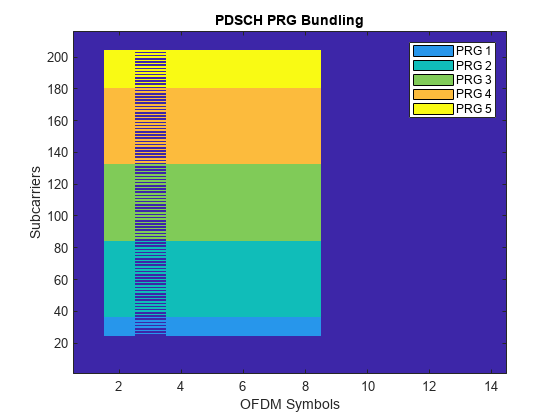nrPDSCHPrecode
Description
Examples
Configure a carrier object and specify the number of transmit antennas.
carrier = nrCarrierConfig; carrier.NSizeGrid = 18; carrier.NStartGrid = 1; ntxants = 4;
Create the carrier grid.
txgrid = nrResourceGrid(carrier,ntxants);
Configure the PDSCH parameters.
pdsch = nrPDSCHConfig;
pdsch.Modulation = 'QPSK';
pdsch.NumLayers = 2;
pdsch.DMRS.NumCDMGroupsWithoutData = 1;Create PDSCH indices for a PDSCH allocated in resource blocks 2 to 16 and 7 OFDM symbols starting at symbol 1. These indices are zero-based.
pdsch.PRBSet = 2:16; pdsch.SymbolAllocation = [1 7]; [portInd,indinfo] = nrPDSCHIndices(carrier,pdsch);
Create a PDSCH codeword and perform PDSCH modulation.
cw = randi([0 1],indinfo.G(1),1); portSym = nrPDSCH(carrier,pdsch,cw);
Create precoding matrices.
prgSize = 4; prgInfo = nrPRGInfo(carrier,prgSize); NPRG = prgInfo.NPRG; W = eye(pdsch.NumLayers,ntxants); W = reshape(kron(2:(NPRG+1),W),pdsch.NumLayers,ntxants,[]);
Perform PRG precoding.
[antSym,antInd] = nrPDSCHPrecode(carrier,portSym,portInd,W);
Map the precoded PDSCH to the carrier grid.
txgrid(antInd) = antSym;
Plot the carrier grid to show the PRGs. The PRGs align with common resoure block (CRB) 0, so only the last physical resource block (PRB) of the first PRG overlaps with the PDSCH allocation. The first CRB (0) is outside the carrier grid because carrier.NStartGrid=1, and the next two CRBs (1 and 2) are outside the PDSCH allocation because pdsch.PRBSet starts as 2.
The last PRG in the allocation can be partial, depending on the allocation size and alignment.
figure; imagesc(abs(txgrid(:,:,1))); axis xy; title('PDSCH PRG Bundling'); xlabel('OFDM Symbols'); ylabel('Subcarriers'); hold on; for i = 1:NPRG patch(NaN,NaN,i+1); end legend("PRG " + (1:NPRG));

Create carrier and PDSCH configuration objects with default parameters.
carrier = nrCarrierConfig; pdsch = nrPDSCHConfig;
Get OFDM information for the carrier configuration.
ofdmInfo = nrOFDMInfo(carrier);
Create an nrTDLChannel System object™.
tdl = nrTDLChannel; P = 3; tdl.NumTransmitAntennas = 3; tdl.ChannelFiltering = false; tdl.SampleRate = ofdmInfo.SampleRate; tdl.NumTimeSamples = tdl.SampleRate * 1e-3;
Specify a PRG bundle size of 2. Get the PRG information for the bundle size and carrier configuration.
prgSize = 2; prgInfo = nrPRGInfo(carrier,prgSize);
Get PDSCH indices for the carrier and PDSCH configurations.
portInd = nrPDSCHIndices(carrier,pdsch);
Create a random precoding matrix.
nLayers = pdsch.NumLayers; nPRG = prgInfo.NPRG; W = complex(randn([nLayers P nPRG]),randn([nLayers P nPRG]));
Get the path gains and path filter impulse responses for the channel.
pathGains = tdl(); pathFilters = getPathFilters(tdl);
Perform channel estimation, extract PDSCH resources, and apply precoding. In this case, the output represents the effective channel between receive antennas and transmit layers.
H = nrPerfectChannelEstimate(carrier,pathGains,pathFilters); [symH,indH] = nrExtractResources(portInd,H); pdschH = nrPDSCHPrecode(carrier,symH,indH,permute(W,[2 1 3]));
Input Arguments
Carrier configuration parameters, specified as an nrCarrierConfig object.
Only these object properties are relevant for this function.
PDSCH symbols, specified as one of these values:
Complex matrix of size NRE-by-NLAYERS, where NRE is the number of resource elements and NLAYERS is the number of layers.
Complex 3-D array of size NRE-by-R-by-P, where R is the number of receive antennas and P is the number of transmit antennas. This array represents the symbols of a PDSCH channel estimate.
This input and the portInd input must have equal
sizes.
Data Types: double | single
Complex Number Support: Yes
PDSCH indices, specified as one of these values:
Matrix of positive integers of size NRE-by-NLAYERS.
3-D array of positive integers of size NRE-by-R-by-P. This array represents the indices of a PDSCH channel estimate.
Data Types: double
Precoding matrices, specified as one of these values:
Complex 3-D array of size NLAYERS-by-P-by-NPRG, where NPRG is the number of precoding resource block groups (PRGs) in the carrier resource grid. Use this size when you specify
portSymandportIndas matrices.Complex 3-D array of size P-by-NLAYERS-by-NPRG, where NPRG. Use this size when you specify
portSymandportIndas 3-D arrays.
This input contains one precoding matrix for each PRG.
Data Types: double | single
Complex Number Support: Yes
Output Arguments
Precoded PDSCH symbols, returned as one of these values:
Complex matrix of size NRE-by-P.
Complex 3-D array of size NRE-by-R-by-NLAYERS. This array represents the effective channel between receive antennas and transmit layers. You can use this option to precode a PDSCH allocation that you extracted from the channel estimate returned by the
nrPerfectChannelEstimatefunction.
The function returns a matrix when you specify portSym and
portInd as matrices, and a 3-D array when you specify them
as 3-D arrays.
Data Types: double | single
Complex Number Support: Yes
References
[1] 3GPP TS 38.214. “NR; Physical layer procedures for data.” 3rd Generation Partnership Project; Technical Specification Group Radio Access Network.
[2] 3GPP TS 38.211. “NR; Physical channels and modulation.” 3rd Generation Partnership Project; Technical Specification Group Radio Access Network.
Extended Capabilities
C/C++ Code Generation
Generate C and C++ code using MATLAB® Coder™.
Version History
Introduced in R2023b
MATLAB Command
You clicked a link that corresponds to this MATLAB command:
Run the command by entering it in the MATLAB Command Window. Web browsers do not support MATLAB commands.
选择网站
选择网站以获取翻译的可用内容,以及查看当地活动和优惠。根据您的位置,我们建议您选择:。
您也可以从以下列表中选择网站:
如何获得最佳网站性能
选择中国网站(中文或英文)以获得最佳网站性能。其他 MathWorks 国家/地区网站并未针对您所在位置的访问进行优化。
美洲
- América Latina (Español)
- Canada (English)
- United States (English)
欧洲
- Belgium (English)
- Denmark (English)
- Deutschland (Deutsch)
- España (Español)
- Finland (English)
- France (Français)
- Ireland (English)
- Italia (Italiano)
- Luxembourg (English)
- Netherlands (English)
- Norway (English)
- Österreich (Deutsch)
- Portugal (English)
- Sweden (English)
- Switzerland
- United Kingdom (English)